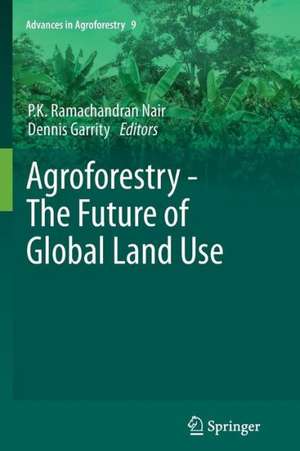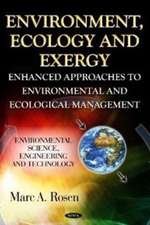Agroforestry - The Future of Global Land Use: Advances in Agroforestry, cartea 9
Editat de P. K. Ramachandran Nair, Dennis Garrityen Limba Engleză Paperback – 21 sep 2014
| Toate formatele și edițiile | Preț | Express |
|---|---|---|
| Paperback (1) | 957.13 lei 6-8 săpt. | |
| SPRINGER NETHERLANDS – 21 sep 2014 | 957.13 lei 6-8 săpt. | |
| Hardback (1) | 971.01 lei 6-8 săpt. | |
| SPRINGER NETHERLANDS – 19 aug 2012 | 971.01 lei 6-8 săpt. |
Preț: 957.13 lei
Preț vechi: 1167.23 lei
-18% Nou
Puncte Express: 1436
Preț estimativ în valută:
183.14€ • 191.22$ • 151.58£
183.14€ • 191.22$ • 151.58£
Carte tipărită la comandă
Livrare economică 05-19 aprilie
Preluare comenzi: 021 569.72.76
Specificații
ISBN-13: 9789401781220
ISBN-10: 9401781222
Pagini: 564
Ilustrații: XXII, 542 p.
Dimensiuni: 155 x 235 x 30 mm
Greutate: 0.78 kg
Ediția:2012
Editura: SPRINGER NETHERLANDS
Colecția Springer
Seria Advances in Agroforestry
Locul publicării:Dordrecht, Netherlands
ISBN-10: 9401781222
Pagini: 564
Ilustrații: XXII, 542 p.
Dimensiuni: 155 x 235 x 30 mm
Greutate: 0.78 kg
Ediția:2012
Editura: SPRINGER NETHERLANDS
Colecția Springer
Seria Advances in Agroforestry
Locul publicării:Dordrecht, Netherlands
Public țintă
Upper undergraduateCuprins
Preface.- List of Authors.- List of Reviewers.- Section I. INTRODUCTION.- Keynote Presentations at WCA2.- Agroforestry, climate change, and habitat protection.- Agroforestry for an ever-green revolution Environmental resilience and agroforestry.- Climate change and agroforestry.- Agroforestry and the transition to the future.- Agroforestry and the future of global land use.- Section II. GLOBAL PERSPECTIVES Based on WCA2 Symposia.- Climate-change mitigation: A low-hanging fruit of agroforestry.- Segregate or integrate for multifunctionality: landscape agroforestry involving rubber in Indonesia and China.- Integrating climate change adaptation and mitigation through agroforestry and ecosystem conservation.- High-carbon-stock rural development pathways in Asia and Africa: Improved land management for climate change mitigation.- Tree domestication in agroforestry: Progress in the second decade (2003–2012).- Policy support for large-scale adoption of agroforestry practices: Experience from Africa and Asia.- Multifunctional Agriculture and opportunities for agroforestry – Implications of IAASTD.- Section III. REGIONAL PERSPECTIVES.- The future of temperate agroforestry in the United States.- Agroforestry research and development in Canada.- Past, present, and future of agroforestry in Europe.- Agroforestry for mine-land reclamation in Germany: Capitalizing on carbon sequestration and bioenergy production.- The Satoyama landscape of Japan: The future of an indigenous agricultural system in an industrialized society.- South Asian agroforestry: traditions, transformations, and prospects.- Agroforestry in the Amazon region: A pathway for balancing conservation and development.- Mainstreaming agroforestry in Latin America.- Land health surveillance: Mapping soil carbon in Kenyan rangelands.- Gender and agroforestry in Africa: Who benefits? – An African perspective.- Incentive mechanisms for smallholder agroforestry: Opportunities and challenges in the Philippines.- Agroforestry – The Way Forward.- Subject Index.
Recenzii
From the reviews:
“This book is derived from the 2nd World Agroforestry Congress, held in Kenya in 2009. Each of its three sections provides a different perspective on agroforestry. … the synthesis of recent information is not duplicated in typical journal articles and represents a significant contribution to the understanding of agroforestry today. Summing Up: Highly recommended. Upper-division undergraduates through professionals.” (B. D. Orr, Choice, Vol. 50 (11), July, 2013)
“The book is well written, beautifully produced and contains a wealth of information on agroforestry today. … All the chapters are of high quality, containing detailed, state-of-the-art, up-to-date information on the different topics of interest to a broader, multidisciplinary audience. … It is of interest to anyone engaged in the practice of agroforestry, forestry or agriculture. … I recommend it to both undergraduates and postgraduate students of agroforestry, forestry, agriculture, ecology orbiology, and that a copy of the book is purchased for institutional libraries.” (Zewge Teklehaimanot, Frontiers of Biogeography, Vol. 5 (3), 2013)
“This book is derived from the 2nd World Agroforestry Congress, held in Kenya in 2009. Each of its three sections provides a different perspective on agroforestry. … the synthesis of recent information is not duplicated in typical journal articles and represents a significant contribution to the understanding of agroforestry today. Summing Up: Highly recommended. Upper-division undergraduates through professionals.” (B. D. Orr, Choice, Vol. 50 (11), July, 2013)
“The book is well written, beautifully produced and contains a wealth of information on agroforestry today. … All the chapters are of high quality, containing detailed, state-of-the-art, up-to-date information on the different topics of interest to a broader, multidisciplinary audience. … It is of interest to anyone engaged in the practice of agroforestry, forestry or agriculture. … I recommend it to both undergraduates and postgraduate students of agroforestry, forestry, agriculture, ecology orbiology, and that a copy of the book is purchased for institutional libraries.” (Zewge Teklehaimanot, Frontiers of Biogeography, Vol. 5 (3), 2013)
Textul de pe ultima copertă
Agroforestry ranks high among the significant initiatives in improving land management that have occurred the world over during the past few decades. Thanks to the global efforts in research and development during the past three decades, the age-old forms of agroforestry are being transformed from a “set of practices in search of science” to a science-based, integrated approach to addressing many of the world’s most serious land-management challenges. Today, nearly a billion hectares of agricultural landscapes already have more than 10% tree cover and an estimated total of 1.6 billion hectares of land worldwide has the potential to be under agroforestry management in the foreseeable future.
The World Congresses of Agroforestry (WCA), held once every five years since 2004, constitute an important set of events in the impressive development of the discipline. The second Congress (WCA2) held in Nairobi, Kenya, in 2009, was attended by about 1,200 delegates from 96 countries. This book was developed to meet the need for a volume containing such outputs that do not fit well into the thematic mode of disciplinary journals. It has been organized into three sections: the Introduction section consists of six summaries of keynote speeches at WCA2; that is followed by two sections of peer-reviewed thematic chapters grouped as “Global Perspectives” (seven chapters) and “Regional Perspectives” (11 chapters), authored by professional leaders in their respective agroforestry-related fields worldwide. A total of 130 professionals from institutions in 33 countries in both developing and the industrialized temperate regions of the world, contributed to the book as chapter authors and/or reviewers. Thus, the book contains a solid body of the current state of knowledge on the various themes and activities in agroforestry worldwide compiled by distinguished leaders in their respective areas of expertise.
The World Congresses of Agroforestry (WCA), held once every five years since 2004, constitute an important set of events in the impressive development of the discipline. The second Congress (WCA2) held in Nairobi, Kenya, in 2009, was attended by about 1,200 delegates from 96 countries. This book was developed to meet the need for a volume containing such outputs that do not fit well into the thematic mode of disciplinary journals. It has been organized into three sections: the Introduction section consists of six summaries of keynote speeches at WCA2; that is followed by two sections of peer-reviewed thematic chapters grouped as “Global Perspectives” (seven chapters) and “Regional Perspectives” (11 chapters), authored by professional leaders in their respective agroforestry-related fields worldwide. A total of 130 professionals from institutions in 33 countries in both developing and the industrialized temperate regions of the world, contributed to the book as chapter authors and/or reviewers. Thus, the book contains a solid body of the current state of knowledge on the various themes and activities in agroforestry worldwide compiled by distinguished leaders in their respective areas of expertise.
Caracteristici
Excerpts of keynote speeches at the 2nd World Congress of Agroforestry, 2009, by Nobel Laureates and other world leaders State-of-the art reviews on various aspects of agroforestry by professional leaders in their respective fields Comprehensive global coverage the current status of agroforestry in both the developing countries and the industrialized temperate regions



























